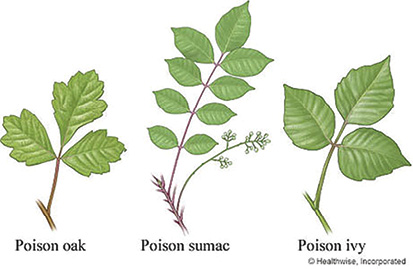September is upon us. Our hot, steamy months of gardening are turning into cooler nights, shorter days and a slow down to the summer planting season. But we are still contending with the weeds. A hot and humid summer, accompanied by a lot of rainfall created the perfect environment for uncontrollable weeds and poisonous vines and plants. These poisonous vines and plants work their way into wood lines and established perennial beds. Even with gloves, clothing and careful care, we get tangled with these awful vines and end up with a nasty, itchy rash.
Let’s get acquainted with New England poisonous plants. It helps to learn how to identify them, and how to treat and slow the spread if we do come in contact.
Poison ivy, poison oak and poison sumac are very common poisonous plants. Touching any of these plants can result in an irritating, itchy skin rash. These plants produce an oil called urushiol that almost everyone is allergic to.
Depending on your sensitivity, a rash may develop within a few hours or a few days after initial contact with urushiol oil. The intensity of the itching can vary, and some people may develop one or two small rashes while others develop rashes all over their bodies. Poison oak and poison sumac rashes look the same, and are treated the same as poison ivy rash. This is because urushiol oil causes the same allergic reaction.
You can’t get a reactive rash by touching another person’s rash because the fluid from blisters doesn’t contain urushiol oil. But you could develop a rash if you touch the oil on another person’s body or clothes. You can also come in contact with the oil by touching your pet’s fur or a contaminated item like a gardening tool or camping gear.
The plants are most dangerous in spring and summer when oil content is highest. But don’t be fooled; in September and after it’s easy to get infected with the poisonous oil. The oil can remain active for months on objects.
You can’t get rid of the rash in one day, but for the fastest relief, you should take the following steps:
• Wash your skin with soapy, lukewarm water as soon as possible. If you don’t wash off the urushiol oil, it can spread to other areas of your body and other people. Make sure to clean under your nails.
• Wash all of your clothes immediately. Urushiol oil can stick to clothing, and if you touch it again, it can cause another rash.
• Wash anything that may have come into contact with the oil, including pets, gardening tools, camping gear or golf clubs. Wear rubber gloves while doing this!
• It’s difficult, but avoid scratching, which can lead to infection.
• If your rash has blisters, leave them alone. Don’t peel off or try to remove the overlaying skin. This skin protects the wound and prevents infection.
A rash from poisonous plants usually goes away within a week or two. In the meantime, over-the-counter (OTC) medications like anti-itch creams, or an antihistamine can relieve the itchy rash. For severe cases, a doctor may prescribe a steroid.
There are two basic ways to get rid of poisonous plants: chemical removal and natural removal. If you use chemical products in your yard or garden, systemic herbicides, especially those formulated for poison ivy and woody plants, are a quick solution. Repeat applications may be necessary because, while herbicides will suppress poison ivy in an instant, the plant may still grow again from the roots.
There are several natural or organic options for killing poison ivy. Pulling the plant out by the roots is an effective way to remove poison ivy. Pulling is a quicker technique for small ivy plants versus larger roots that may require digging. Before tackling this job, outfit yourself in protective gear. Make your own weed killer with one cup of salt, one tablespoon of dish soap and one tablespoon of vinegar in a gallon of water. Another method is to boil water in a kettle and carefully pour water over the plants to drown the roots. Repeat often to kill the roots over time. A tactic for small areas is to place plastic or cardboard over the area after pulling the poison ivy out of the ground. Secure the plastic or cardboard to smother the plants.
When I wrote this column, I was lathered with anti-itch cream, staying in air conditioning, and reminding myself to be more diligent with my gardening. Many thanks to the Cleveland Clinic for the information I researched to share with you. May your September gardening experiences be itch free!
